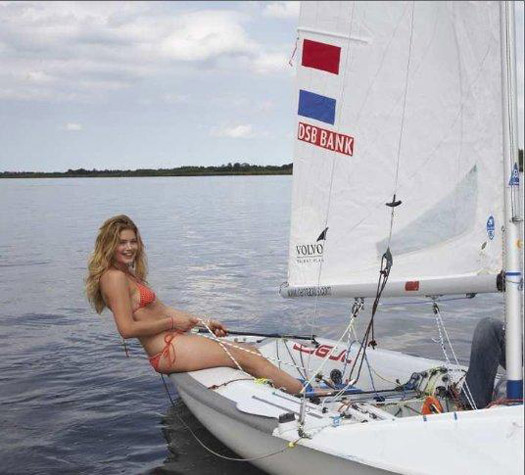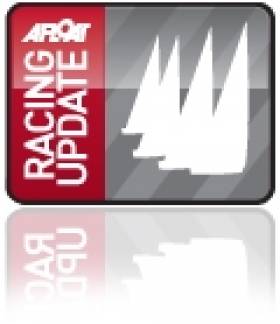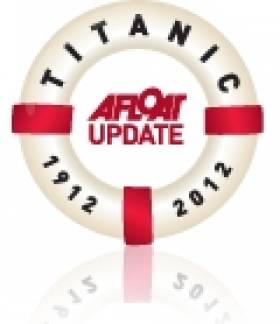Displaying items by tag: model
Home Built Model Yacht Racers Prove Competitive
With the recent series of storms model yacht racers had to cancel a number of events but a few managed to get on the water. We had a friendly outing in Gortin lake in November and another one on Lough Erne last weekend writes Gilbert Louis.
One of the main comments about these 2 outings is that most of the boats that you see in the pictures and videos are home built. Most of these wooden boats were built by Neill Suitor a sailing enthusiast from Northern Ireland who clearly has ‘golden fingers’ to build these beauties. Having said this, others also built their own boat. Trevor Fisher and Bob Wells also from Northern Ireland built a Goth XP design in wood. Des Dwyer and Sephen Fay from Dublin built an Alternative design… (Alternative is the actual name of the boat design. This boat was designed by Brad Gibson).
The IOM class is not a one design but a box rules where the rigging is pretty much one-design but the class rules allow for creativity and designs opportunity with the hull. This ensure evolution of the class while keeping the cost down and all boats racing competitively together.
This allows home designs and home built boat to be as competitive as series built fiberglass boats and this is a really good thing.
Brad for example who’s multiple world and European champion designs and builds his own boats and his sails. One of the successful German skipper also designed and built his own boat, sails and even his rigs with wooden rigging with pre-bend in them. While this amateur building is still a minority amongst IOM skippers it shows that whether you buy a ‘production’ boat or build it yourself you can be competitive in the class.
I race with a wooden boat designed by Frank Russell, a well-known model boat designer from Australia (http://www.frankrusselldesign.com/) which was built by Neill Suitor. I finished 5th in national regatta in France in Autumn last year with it. I was the only competitor there racing a wooden boat but I was racing against all the latest designs (Britpop, V8, V9, Fraktal, MX, cheinz, etc…).
The Irish fleet is currently enjoying growth in the Cork region and in Northern Ireland at the moment which is encouraging.
In Dublin, Howth YC which is a great base for the Dublin fleet is hosting the regular Winter and Spring series with events every 2 weeks.
Looking forward to see you on the water! Or rather ashore with us to control your boat ;-)
Gilbert Louis
18 Model Boats Skippers Contest Ulster IOM Title
#modelboats – Despite an uneasy weather forecast and torrential rain during the week model boat skippers heading for the Ulster IOM championships just couldn't complain about the weekend as we had light wind, a good few sunny spells and no rain at all writes Gilbert Louis.
With this in mind we had more skippers than last year's Ulster's championships. They came from the Republic, Northern Ireland, Scotland and England, 18 in total.
Saturday saw the whole fleet of 18 boats sailing together. Despite talks of splitting into 2 fleets the decision was made to keep us all in one fleet which has one key advantage. We get twice as many race and time on the water and this is part of sailing.
The format was sets of 3 races pretty much back to back with only a few minutes for skippers to make adjustments if needed between the races, to tune their boats to the conditions. Or giving an opportunity for quick fixes in case of brakeage.
Then a longer break before the next set of 3 races. This format allowed us to spend great time on the water and get the most of the day sailing not watching others sail. Everyone enjoyed it.
Sure it also made for spectacular starts ! 18 boats on the starting line is not something we're used to so you have to be on the first line or you get spat out at the back very quickly after the start. This is excellent training for us as we don't have that experience in Ireland but that's what they do at international levels so a good exposure for us.
The trick is to be amongst the front line of boats in the last few seconds before the start. You need to make your space and defend it. Not easy when you're in your boat, even more difficult when you have your boat in a swarm of other boats all looking to have the perfect start.
The start and first beat to the weather mark will dictate pretty much 70-80% of your race result. It is so much easier to control the fleet from the front then try to sail through it to get there. Particularly when there is very little difference in boat speed. It is too easy when you're behind to say my boat is not as fast as the other at the front but actually I found that my boat speed particularly on the Sunday was very similar to them. So the difference is elsewhere: a good start, clean air, going on the right side, staying clear of contacts and good tacks. Yes the difference will show in making mistake on any of these and at the end when you add all the boat lengths you lost in a bad tack, going the wrong side or worth a bad start and I don't even count getting cought up with other boats, penalties and these add up to several boat lengths and places between you and the first boat.
Jeff Kay from HYC who's our most experienced skipper having competed at several European and World championships was able to use that experience and get great starts and was "fighting" for top 5 places on regular basis.
There were 5 of us coming from the Republic: Jeff and his brother Stephen Kay, both racing the now very popular and successful Britpop designed by Brad Gibson. Then Des and myself sailing a XP designed by Frank Russell, and Oscar, a new addition to our fleet who came to compete for his first ever IOM regatta with my trusty V6 designed by Ian Vickers.
The intensity of the races back to back took its toll on Jeff's back and he had to sit a a number of races despite really good performance on the water.
Stephen did well up until his electric issue started. He got very irregular results due to a random receiver problem which got worse and forced him to abandon the event. A real pity as he also had the pace.
Des struggled on the saturday with his XP, trying to find a good tuning for the light wind conditions and his work paid out as he was right in the fight on day 2.
Gilbert was trying his brand new XP which only touched the water once before for the floatation test so it was very much unknown whether that design could match the reputable speed of the Britpop. Race after race Gilbert fixed a number of teething problems which improved reliability and upwind performance but an alignment problem of the gooseneck forcing the main boom upwards as the sheets were eased, spilling the wind out meant that he coudn't gain places on the downwind legs but was rather loosing some.
On day 2 and a fixed gooseneck Gilbert managed to bring the pace of the boat closer to the best. But the starts were still a problem which coudn't be fixed in tuning. Yet race after race he was working his way up to the front of the fleet and finished on a high as he managed a stunning start of the last race and after good tactical decision led at the weather mark and managed to keep no 46 britpop at bay to lead to the finish. So the XP has potential, more time sailing in different conditions will give us more information on this new design.
Bottom line we still have work to do in Ireland to match the Scots and English but we're making progress which is encouraging. A great meal at Paddy's barn pub put an end to this great event before people left to get their ferry back.
Supporting this event is our repeat sponsor Catsails so thank you Nigel and Sue for your on going support.
Brian O'Neill planned and organised this event with the support of Bill, Ali and others making this year's event another great success.
Next is the Winter Series in Howth Yacht Club that starts shortly.
Model Boat Racers Ask the Question: 'To Chine or not to Chine?'
#modelboat – The model boat classes have been experimenting with chines for a while now. We have seen a new trend over the recent years in boat designs. This new wave came from the racing boats, TP52, VOR70, and recently making its way to the cruiser racer designs like the new X boats or Malango to name a few. The funny thing is that not until recently chined boats were still built by amateur builders as they are easier to build. Yet now we are coming back to them, the 10R, A class, Marblehead and also the One Metre class are now coming out with chine.
The IOM or International One Metre Class operates under a box rules format. This, in a nutshell, allows for a relatively open format to boat designs but the rules on the number of rigs and their dimensions are very stricts.
This ensures close racing as we have seen over the years. For the past couple of years the arrival of chines on boat design increased the performance of these boats a notch up. However there are still many debates about the chine and its effect on performance. From what I have seen and tested so far, I can give 3 advantages of the chine design over rounded hulls:
1- the chine helps the boat to accelerate that bit quicker after a tack.
2- It allows to track nicely on the beat versus a rounded hull that would "slide" more as it heels in the gusts.
3- it helps the boat to get planning that little bit earlier and longer on the run
there is a 4th point often discussed within the class. That boats with chines tend to nose dive less in the gusts and accelerate more. I agree to some extend as in my opinion this is primaliry due to more volume in the forward section, complemented by a higher radius of the foredeck to help the come up should it nose dive. I am not of the view that the chine helps here, and the proof is that Brad Gibson who made the most successful chine design, did design another boat before called the SKA which goes well downwind and has no chine.
See the pictures attached to see the difference in designs and even amongst the chined boats, its length, position and angle varies across the design range.
So does that means that rounded boats are passed their due date ? No not at all, not later than a month ago I won an event in Scotland with my 2006 V6 which has a rounded hull, ahead of newer chined boats. There are many other rounded hulls that are at least as successful like the Obsession, the V7 to name a few.
There is it seems a "fashion" trend to go and get a chined boat, but like any other sailing class you can focus on the little things and miss on the big picture. Like getting the tuning of the boat wrong, opting for the wrong rig, an electric failure, a bad start, seaweed in the keel, a wrong tack, overstanding a mark, and the list goes on. One has more to lose in doing any of these errors than not getting a chined boat.
Titanic Scale Model Focus of High Court Dispute
#TITANIC - A replica of the Titanic is at the centre of a High Court dispute between two former partners, as RTE News reports.
Carmel McGrath claims she paid the costs of constructing the 16ft scale replica of the tragic cruise liner, and has secured an injunction preventing Zoltan Panka, a Hungarian national, from selling the €70,000 model after he removed it from her home in the northern suburbs of Cork.
Panka gave a sworn statement to the court disputing the claims of his former partner, alleging he received abusive messages from her after taking the model.
He denies any intention to sell the replica, currently believed to be at a location in Carrigaline, and repudiates the estimated value of McGrath's investment as well as any commercial relationship between the two.
The Hungarian added that model ship building was a family hobby, and that he had put in as much as 2,000 hours' worth of work into the uncompleted project, which was intended to mark the 100th anniversary of the ship's demise.
RTE News has much more on the story HERE.
Supermodel Sells Her 470 Dinghy
One of the world's top supermodels, Doutzen Kroes of the Netherlands, is selling her 470 sailing dinghy for charity. Doutzen and her 470 have already become famous in the Douwe Egberts coffee advert which features Doutzen reminiscing over her 470, which she has mainly enjoyed sailing recreationally.

Doutzen Kroes sailing her 470 dinghy (above) and below at work
Twenty-six year old beauty Doutzen, who has been the face for many leading consumer brands and fashion houses, has offered her 470 dinghy for the highest bids on the leading Dutch auction website www.marktplaats.nl
Earlier this week, bids of Euros 1,000,000 were made, but as Doutzen recognized in an interview on Radio 538, one of Holland's leading radio stations, "There are bids of Euros 1,000,000 but I think they are not realistic. I have received a serious bid of Euros 20,000. I hope for more people to make a higher bid in favour of Dance 4 life."
ISORA Entry List 2011
Up to 40 yachts form the backbone of the Irish Sea Offshore Racing Association fleet (ISORA). Although the 2011 entry list (below) shows a large number of Beneteau models it also reveals a wide range of other marques, largely between 30 and 50 foot. Prominent types are J109s, Sigma 33s and a number of Jeanneau yachts too.
ISORA 2011 Racing Fleet
| Boat Name | Sail no | Hull / Mast Col | Model |
| Lancastrian | GBR7682T | White | Starlight |
| Yahtzee | IRL 1068 | White/Gold | Oceanis 41 |
| Rebellion | IRL 6001 | Blue/Silver | Nicholson 58 |
| Miss Scarlett | IRL 4763 | White/Gray | Sunfast 40.3 |
| Orna | IRL532 | Blue | 40C |
| Mistral of St Helier | K8337 | White | 3800D |
| Poppy | GBR4183 | Red/White | Contention 33 |
| Dinah | IRL 3508 | White/Aluminium | Jeanneau |
| Raging Bull | IRL 9666 | White/Silver | Sigma 400 |
| Tsunami | IRL 4007 | Grey/Silver | First 40.7 |
| GFT Adventurer | GBR 23161 | White/Silver | First 45 |
| Jedi | IRL 8088 | J109 | |
| English Mick | GRB 4771R | Blue/Silver | First 47.7 |
| Galileo | IRL1944 | Blue | First 47.7 |
| Lula Belle | IRL3607 | White | Beneteau 36.7 |
| Finnigans Wake | IRL2008 | White | 37B |
| Obsession | IRL 4513 | White/Aluminium | Sigma 3300 |
| Katanca | IRL 31310 | White/Aluminium | Elan 31 |
| Just Enough | GBR6912T | J92 | |
| Big Hillie Style | IRL 3208 | White | Sun Fast 3200 |
| Adelie | FRA 9631 | White/Black | First 34.7 |
| Mojito | IS 36L | White/Aluminium | Bavaria |
| Calypso | IRL 5643 | White/Silver | Oceanis E51 |
| Legally Blonde | IRL 3175 | Grey/Aluminium | Beneteau |
| GWAWR | GRB 8330 | White/Aluminium | Sigma |
| First of September | IRL 8581 | White/Silver | First 435 |
| Rollercoaster | IRL 9109 | White/Aluminium | J109 |
| Quite Correct | IRL 5405 | White/White | Jeanneau D5 54 |
| Sarnia | IRL 2260 | White/Gold | 36 |
| Sailing West Intuition | GBR 9383R | Blue/Aluminium | Reflex 38 |
| Sailing West One Life | GBR 3708R | White/Silver | Sunfast 37 |
| Temper Tantrum | 6909T | White | 40 |
| Wennol 3 | GBR1347R | White/Black | First 34.7 |
| African Challenge | IRL 2649 | White/Silver | Fast |
| Windshift | IRL37737 | White/Aluminium | Sunfast 37 |
| Oystercatcher | IRL 1177 | White/ Silver | Gib'sea 37 |
| Aztec 3 | IRL29832 | White/Silver | A35 |

































































